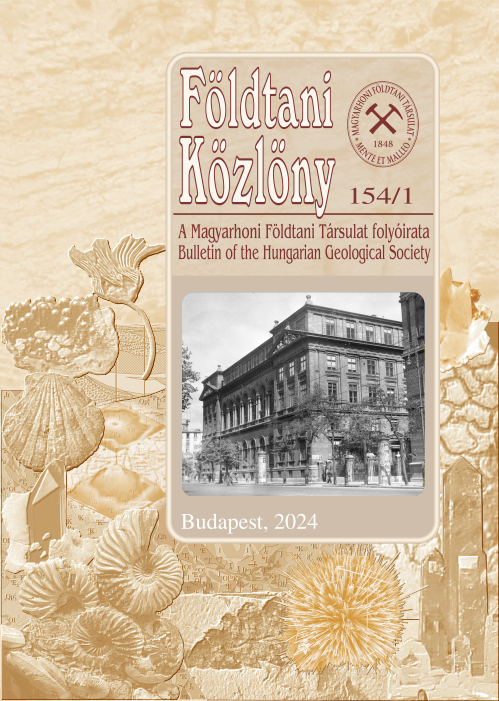Upper Triassic conodonts from deep boreholes of the Recsk–Darnó area: new data on the geology of its pre-Cenozoic basement
Abstract
This study evaluates and summarizes the Triassic conodont data gained from the pre-Cenozoic basement of the Recsk Palaeogene volcanic complex (representing the NE-most occurrence of the Periadriatic–Balaton magmatic range) and
from the Mesozoic of the adjacent Darnó Hill area. Evidence is given to show the Carnian, Norian and Rhaetian age of the studied formations. More than 100 deep drillings (each of them 1000–1200m deep, with continuous coring) were used to explore the basement of the Recsk ore-field in connection with extensive ore exploration and mine construction works which took place during the 1960s and 1970s. Syntheses of the knowledge accumulated about the pre-Cenozoic basement around about the time of the exploration and construction were presented by FÖLDESSY 1975; FÖLDESSY & JÁRÁNYI 1975; BALLA et al. 1980, 1981 and ZELENKA et al. 1983a, b. Unfortunately, when these syntheses were formulated, application of modern sedimentological and biostratigraphic methods in Hungary was still at an elementary stage.
After the closure of the Recsk ore mine in the middle of the 1980s, most of the drill cores were selected for elimination. However, about 25 of them were redeposited in the core depository of the Hungarian Geological Institute at Rákóczibánya, and they are still avaliable there for modern studies. New, detailed investigations of dome-key drill cores began in the middle of the 1990s (DOSZTÁLY 1994, JÓZSA et al. 1996, JÓZSA 1999). These investigations indicated that the tectonostratigraphic units distinguished in the western part of the Bükk Mts (see CSONTOS 1999 and PELIKÁN 2005 for the latest reviews) could also be recognized in the pre-Cenozoic basement of the Recsk–Darnó area (HAAS & KOVÁCS 2001,
DOSZTÁLY et al. 2002, KOVÁCS et al. 2011).
At its highest position the Darnó Unit/Complex (s.s.) consists of basic extrusive (basalts) and intrusive (gabbros, in a smaller amount) rocks; these are associated with Triassic and Jurassic abyssal sediments (pelagic mudstones/shales,
siliceous shales, radiolarites). The Complex occurs on the surface in the Darnó Hill area, but to the NW of the Darnó Fault it is missing in the basement of the Palaeogene volcanic complex. (This is probably because it had been eroded prior to
the Late Eocene, before the beginning of volcanic activity.) The Mónosbél Unit/Complex, in its median position, represents a redeposited sedimentary complex of Jurassic age; its sedimentary setting is mostly of a 'toe-of-slope'-type. Dark grey shale and bluish grey siliceous shale constitutes the “normal” or “autochthonous” sediment (frequently showing, however, a distal turbiditic character as well). This sediment alternates with limestone turbidites. Manifestations of repeated sediment-gravity movements (e.g. slumps, debris flows/“micro-olistostromes”) are common. Furthermore, some sansdstone clasts show evidence of enrichment in some of the debris flow horizons.
Another characteristic is the several metres- to tens of metres-sized slide blocks (olistothrymmata) of Triassic red, siliceous, cherty limestone (Bódvalenke Limestone). This is associated with amygdaloidal basalt and Hallstatt-type limestone.
The Bükk Parautochthonous Unit (“Bükk Complex s.s.”), in its lowest position, consists of formations which correspond to the Bükk “normal” succession; these formations occur from beneath the Mónosbél Unit/Complex in the Recsk ore-field. (This unit was not reached by the Darnó Hill boreholes.) Conodonts recovered from different drill cores which penetrate these units (their setting is shown on Figure 2, ) were as follows: (a) Darnó Unit s.s.: some Lower to Middle Carnian conodonts (listed in the Hungarian text) were found in grey, micritic limestones of the drill core Rm–136 (see Figure 6). Unfortunately, samples from red micritic limestones intermixed with basalts (peperitic facies) in the investigated interval (352.32 to 380.70m) were barren of conodonts. On the other hand, DOSZTÁLY (in JÓZSA et al. 1996) reported Ladinian radiolarians from the top part of the block (354.8m). (b) Mónosbél Unit: the borehole Rm–118 (see Figure 5) penetrated between 883.7–969.5m (according to the original documentation). Here, a large Triassic slide block (olistothrymma) was observed, with a virtual thickness of 85.8m. It











